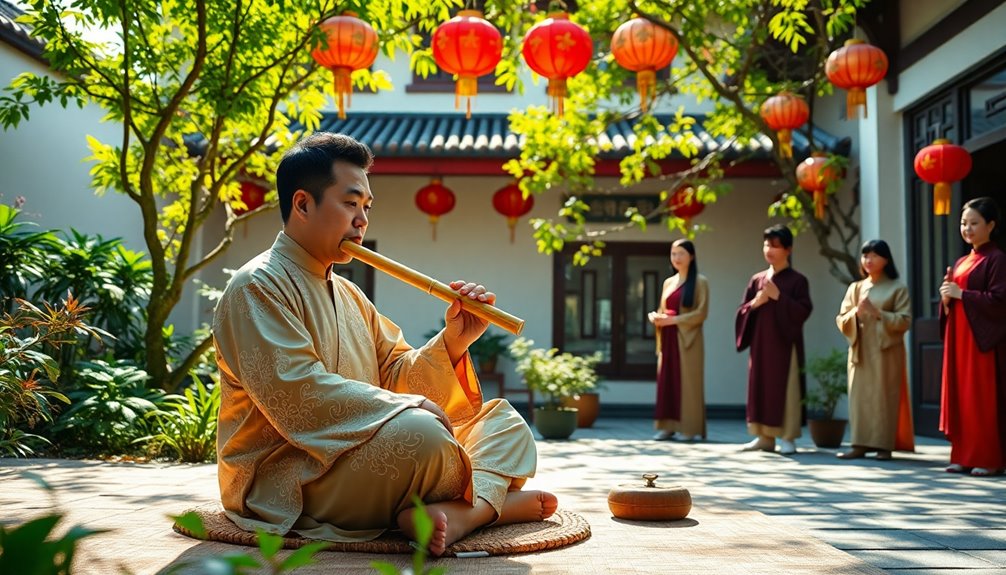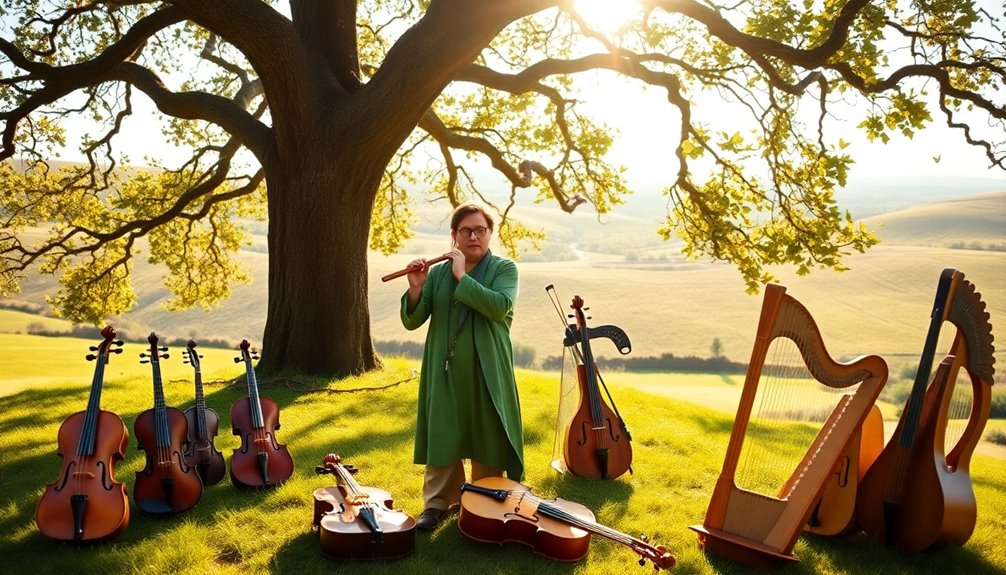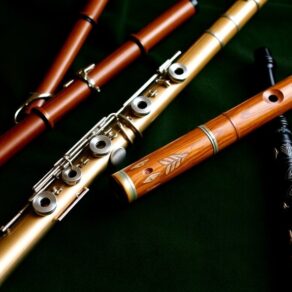The flute plays a pivotal role in various global traditional music genres, enriching cultural expressions across continents. In Indian classical music, the bansuri enhances emotional depth, while Native American flutes evoke nature's spirit and storytelling. Chinese traditional music incorporates the dizi, embodying themes of love and history. Celtic folk music weaves flutes into narratives, fostering communal connections. Andean music showcases unique flutes that reflect the region's vibrant culture. Each genre not only highlights the flute's versatility but also preserves rich heritages. Exploring these traditions further reveals the flute's significant cultural impact worldwide.
Key Takeaways
- Indian classical music prominently features the bansuri, enhancing emotional depth in raga improvisations.
- Native American flute traditions use local woods to create melodies that embody storytelling and connection to nature.
- The dizi is central to Chinese traditional music, reflecting themes of nature, love, and history.
- Celtic folk music incorporates flutes, creating distinctive sounds that engage communities through shared narratives and dances.
- Andean music showcases unique flutes, highlighting cultural expression and breath control techniques integral to its traditions.
Indian Classical Music

In the domain of Indian classical music, the flute, particularly the bansuri, holds a revered position, weaving intricate melodies that resonate deeply with cultural and spiritual significance. Crafted from bamboo, this flute isn't just a musical instrument; it's a vessel of expression, embodying the soul of its players.
You'll find that in the context of raga improvisation, the bansuri plays a significant role, allowing musicians to explore and innovate within established frameworks of melody.
When you listen to a bansuri performance, you witness a dialogue between the artist and the audience, where every note conveys emotion and intention. The interplay of raga—each with its own mood and time—is essential, as it dictates the improvisational journey.
Musicians often draw from a deep well of traditional knowledge, yet they infuse their unique voice, creating fresh interpretations that keep the art form alive. The bansuri's distinctive timbre allows it to soar above other instruments, enhancing the emotional depth of performances.
As you investigate the world of Indian classical music, you'll notice how the bansuri acts as a bridge, connecting the past with the present. It invites you to experience the nuances of ragas, where silence and sound coexist harmoniously.
Engaging with this music cultivates a sense of belonging, as you become part of a rich tapestry of traditions that span centuries. Embrace the transformative power of the bamboo flute, and let its melodies guide you through the intricate rhythms of life, echoing the timeless stories of love, devotion, and spirituality inherent in Indian culture.
Native American Flute Traditions

Embodying the spirit of the earth and sky, the Native American flute serves as a profound means of storytelling and cultural expression. Its haunting melodies connect you deeply to nature and the rich tapestry of Native American history.
When you explore the flute's construction, you'll discover that each instrument is typically crafted from wood, with specific types varying by region, reflecting the local resources and traditions. This craftsmanship isn't merely functional; it embodies a cultural significance that transcends time.
As you learn about the various tribes, you'll find that the flute holds different meanings across cultures, often associated with love, healing, and spiritual connection. For many Native American communities, the flute is more than an instrument; it's a voice that conveys emotions and narratives that words sometimes cannot.
When you hear a flute playing, it evokes images of nature—the rustling leaves, flowing rivers, and the whisper of the wind—reminding you of your bond with the environment.
Participating in this tradition allows you to feel a sense of belonging to something greater than yourself. You're not just an observer; you become part of a living heritage that celebrates life, love, and connection.
Through its sound, the Native American flute invites you to reflect on your place within the world and the stories that shape your identity. Embrace the opportunity to engage with this profound cultural legacy, and let the flute's melodies resonate within you. Additionally, the choice of high-quality woods greatly influences the flute's sound and durability, enhancing your musical experience.
Chinese Traditional Music

Chinese traditional music often captivates listeners with its rich history and diverse array of instruments, reflecting the country's vast cultural landscape. Central to this musical heritage is the bamboo flute, known as the dizi, which plays a pivotal role in Chinese folk music. The dizi, crafted from bamboo, produces a warm, resonant sound that evokes deep emotions, connecting you to the heart of Chinese culture.
As you explore traditional melodies, you'll notice how they often incorporate themes of nature, love, and history, showcasing the cultural significance of the music. Each note and rhythm tells a story, inviting you to experience the values and beliefs inherent in Chinese society. The melodies aren't just for entertainment; they serve as a bridge between past and present, allowing you to partake in a shared cultural identity.
In various regional styles, the bamboo flute adapts to local traditions, yet maintains its essence. Whether in the context of a festive celebration or a quiet moment of reflection, these performances create an intimate connection among listeners. By engaging with Chinese folk music, you're not just appreciating the artistry; you're participating in a living tradition that has spanned centuries. The wooden flute piccolo is another traditional instrument that embodies the enchanting sound and cultural richness of Chinese music.
Ultimately, the allure of Chinese traditional music lies in its ability to foster a sense of belonging. As you immerse yourself in these melodies, you become part of a community that values the rich tapestry of its history and the profound messages conveyed through the soulful sounds of the bamboo flute.
Celtic Folk Music

Celtic folk music offers a vibrant tapestry of sounds that reflect the rich cultural heritage of Ireland, Scotland, and Wales. As you explore this genre, you'll find that the flute plays a pivotal role in weaving together melodies that echo the spirit of Irish folklore. The enchanting tunes often evoke a sense of nostalgia, reminding you of tales passed down through generations.
In Celtic folk music, you'll encounter a variety of Celtic instrumentation that enhances the overall experience. The flute, with its sweet and airy tones, harmonizes beautifully with other instruments, creating an immersive soundscape. High-quality materials used in instruments like tin whistles contribute to a clearer tonal quality, enriching the musical experience.
Here are a few elements that define this genre:
- Traditional Instruments: The interplay of flutes, fiddles, and tin whistles creates a distinctive sound that's uniquely Celtic.
- Storytelling Through Music: Each tune is often linked to a story or legend, inviting you to explore the rich narrative tradition of the Celtic cultures.
- Community and Celebration: These musical gatherings foster a sense of belonging, where everyone can participate in the joy of shared songs and dances.
Engaging with Celtic folk music isn't just about listening; it's about connecting with a community that cherishes its roots. As you immerse yourself in these sounds, you'll realize that each note carries the weight of history, inviting you to become part of a living tradition that celebrates life, love, and the landscapes of the Celtic world.
South American Andean Music

As you shift your focus to South American Andean music, you'll discover a genre deeply rooted in the diverse cultures of the Andes Mountains, encompassing countries like Peru, Bolivia, and Ecuador. This vibrant music is characterized by its unique instrumentation, particularly the Andean flute and panpipes, which evoke both the grandeur and intimacy of the high-altitude landscapes.
The Andean flute, often made from bamboo or other local materials, produces a sound that resonates with the spirit of the mountains. You'll notice how musicians adeptly use panpipes techniques, such as varying breath control and finger positioning, to create haunting melodies and intricate harmonies. Each note tells a story, connecting you to the ancestral traditions and communal practices of the Andean people.
In this genre, music serves not just as entertainment, but as a means of cultural expression and identity. The rhythms and melodies reflect the daily lives and celebrations of Andean communities, allowing you to feel a sense of belonging to a rich tapestry of history. Additionally, the craftsmanship of bamboo flutes plays a significant role in the instrument's sound quality and overall performance.
As you immerse yourself in this music, you'll appreciate how it bridges generations, preserving folklore and rituals through sound. Listening to Andean music is an invitation to explore a world where nature and culture intertwine.
Japanese Gagaku

Gagaku, Japan's ancient court music, offers a mesmerizing glimpse into the country's rich cultural heritage. This genre, which has evolved over centuries, showcases a unique blend of influences from China and Korea, reflecting Japan's historical interactions with its neighbors. Understanding Gagaku means delving into its instrumentation and the historical context that shaped it.
The Gagaku ensemble typically features a range of instruments, including:
- Shō: A mouth organ that produces rich, harmonious chords.
- Hichiriki: A double-reed flute that delivers a penetrating sound, often leading the melody.
- Biwa: A four-stringed lute that adds depth and texture to the ensemble.
Gagaku history dates back over a thousand years, serving as both entertainment and a vehicle for spiritual expression in Imperial courts. This music not only represents Japan's artistic achievements but also embodies the philosophical and aesthetic values of the time.
The slow, deliberate pace of Gagaku compositions encourages contemplation, inviting listeners to connect with the past and experience a sense of tranquility. The unique timbre of the hichiriki plays a vital role in creating the ethereal quality that characterizes Gagaku music.
As you immerse yourself in Gagaku, you're not just listening to music; you're participating in a cultural narrative that transcends generations. By appreciating Gagaku, you join a community that values tradition, history, and the profound beauty of sound.
Whether it's the ethereal tones of the shō or the haunting melodies of the hichiriki, each note resonates with centuries of Japanese heritage, creating a sense of belonging that's both timeless and universal.
African Tribal Music

While exploring the diverse landscape of African tribal music, you'll discover a vibrant tapestry woven from countless cultural threads, each representing unique traditions and histories. At the heart of this musical genre lies the flute, an instrument that embodies the essence of community and connection. You'll find various types of flutes, from the end-blown types to the transverse varieties, each crafted from local materials and played during significant communal events.
African rhythms play a vital role in shaping the soundscapes of tribal music. They're not just patterns; they serve as the heartbeat of cultural expression. When you listen closely, you'll notice how these rhythms align with dance, storytelling, and rituals, enriching the overall experience. The flute often carries melodies that complement these rhythms, creating a dialogue between the instrumental and the communal.
The cultural significance of African tribal music extends beyond mere entertainment. It acts as a vessel for passing down history, preserving languages, and strengthening social bonds. When you participate in or witness these musical traditions, you're not just an observer; you're part of a living narrative that celebrates shared identities and collective memories. The flute's role in these traditions highlights its importance in traditional folk music, where it conveys stories and cultural heritage.
In essence, African tribal music, with its intricate flute melodies and compelling rhythms, invites you to embrace a deeper understanding of the rich cultural landscapes that define this continent. By engaging with these traditions, you foster a sense of belonging that transcends borders and connects you to the universal human experience.
Frequently Asked Questions
What Types of Flutes Are Used in Indian Classical Music?
In Indian classical music, you'll encounter a variety of flutes, each with unique characteristics. The bansuri, a bamboo flute, is prominent, known for its expressive bansuri technique that brings traditional compositions to life.
You'll appreciate how its melodic nuances evoke deep emotions, connecting you to the rich cultural heritage of India. Other flutes, like the nadaswaram, also play significant roles, enhancing the diverse soundscape that invites you into this vibrant musical world.
How Do Native American Flute Rituals Vary Among Tribes?
When you explore how Native American flute rituals vary among tribes, you'll find rich traditions tied to flute symbolism and tribal ceremonies.
Each tribe embraces unique stories, melodies, and meanings associated with their flutes, reflecting their cultural identity.
Some use flutes in healing ceremonies, while others might incorporate them in spiritual or seasonal celebrations.
Understanding these differences helps you appreciate the profound connection between music and community in Native American culture.
Are There Famous Chinese Flute Players to Know?
When it comes to the world of music, China's flute scene shines like a beacon.
You should definitely know about famous players like Guo Gan and his mastery of traditional techniques.
They've breathed new life into ancient sounds, blending innovation with culture.
By exploring their work, you'll not only appreciate the flute's beauty but also feel a deeper connection to the rich tapestry of Chinese musical heritage.
It's an experience worth diving into!
What Themes Are Common in Celtic Flute Music?
In Celtic flute music, you'll find themes deeply rooted in Celtic folklore, often weaving tales of love, nature, and myth.
The melodies typically reflect the spirit of the land, invoking a sense of nostalgia and belonging.
You'll also notice lively dance rhythms that invite listeners to move and celebrate together.
This blend of storytelling and joyful movement creates a rich tapestry, connecting you to the cultural heart of the Celtic tradition.
How Is the Andean Flute Crafted Traditionally?
When you explore how the Andean flute is crafted traditionally, you'll discover a rich tapestry of materials and techniques.
Artisans often use indigenous woods like bamboo and cedar, ensuring a connection to the land. They employ unique techniques, like hand-carving and natural tuning, to create instruments that resonate deeply with cultural identity.
Each flute tells a story, inviting you to engage with the vibrant heritage of Andean music and its community.
Conclusion
As you explore the rich tapestry of global traditional music, notice how the flute serves as a bridge between cultures. From the intricate ragas of Indian classical music to the haunting melodies of Native American traditions, each style reveals a unique narrative. Juxtaposed with the vibrant rhythms of South American Andean music or the serene elegance of Japanese Gagaku, the flute transcends boundaries, connecting diverse histories and emotions, inviting you to listen deeply and appreciate our shared humanity.






